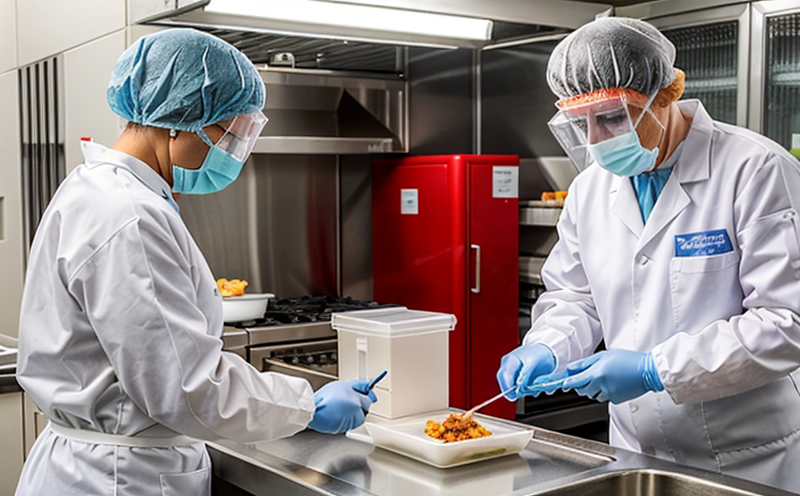ISO 29263 Detection of Hepatitis E Virus in Pork Products
The detection and quantification of Hepatitis E virus (HEV) in pork products is critical for ensuring food safety, especially given the increasing global demand for pork. ISO 29263 provides a standardized method to detect HEV RNA using reverse transcription polymerase chain reaction (RT-PCR) technology.
Our laboratory offers comprehensive testing services following this international standard to help ensure that pork products do not contain harmful levels of HEV. This service is particularly important in regions where pigs are commonly infected with HEV, as it can be a significant source for human infection.
The process begins with the collection and preparation of samples from pork carcasses or processed meats. Sample preparation involves homogenization followed by viral RNA extraction using approved reagents like QIAamp Viral RNA Kit (Qiagen) to ensure high-quality nucleic acid suitable for RT-PCR analysis.
Our laboratory uses state-of-the-art instrumentation such as the Applied Biosystems 7500 Real-Time PCR System, which provides accurate and precise quantification of viral load. The protocol strictly follows ISO 29263 guidelines to ensure consistency and reliability across tests conducted by our team.
A key aspect of this testing is the use of positive and negative controls in every run to validate the integrity of reagents and minimize false-positive or -negative results. This ensures that only pork products free from detectable levels of HEV RNA are allowed into the market, thereby safeguarding public health.
The acceptance criteria for passing this test are based on ISO 29263: The sample is considered negative if no amplification signal is detected within a specific cycle threshold (Ct) value range. For quantification purposes, any Ct value below this threshold indicates the presence of HEV RNA at concentrations exceeding allowable limits set by regulatory bodies.
Our team of experts works closely with clients to ensure that all samples are handled meticulously from collection through analysis. We also provide detailed reports outlining test procedures and results, which can be crucial for compliance with local regulations or internal quality control processes.
By adhering strictly to ISO 29263 standards, we help our clients maintain the highest levels of food safety while complying with international best practices in laboratory testing. This service is essential not only for protecting public health but also enhancing consumer confidence in pork products globally.
Benefits
The implementation of ISO 29263 detection protocols offers numerous benefits to the food industry, particularly those involved in pork production and processing. By ensuring that HEV is detected early and effectively managed, businesses can mitigate risks associated with viral contamination.
- Increase consumer trust: Ensuring that pork products are free from HEV enhances brand reputation and builds customer confidence.
- Compliance with regulations: Adhering to international standards like ISO 29263 helps avoid legal issues and penalties associated with non-compliant products.
- Improved product quality: Early detection allows for prompt corrective actions, reducing the risk of contaminated batches reaching consumers.
- Sustained market access: Meeting stringent testing requirements can help maintain favorable trade relationships and open doors to new markets.
In summary, our ISO 29263-based HEV detection service provides robust protection against viral contamination in pork products, contributing significantly to overall food safety measures.
Environmental and Sustainability Contributions
- Reduction of waste: By ensuring that only safe pork products enter the market, this testing minimizes potential environmental impacts from contaminated products. This practice supports sustainable agricultural practices by preventing unnecessary disposal or reprocessing.
- Energy efficiency: Efficient use of resources in sample preparation and testing processes contributes to reduced energy consumption compared to less precise methods.
- Biosecurity measures: Early detection helps implement effective biosecurity protocols, which can prevent the spread of HEV within farms and processing plants, thereby promoting sustainable animal health management practices.
The rigorous application of ISO 29263 supports a more environmentally responsible approach to pork product testing, aligning with broader sustainability goals.
Use Cases and Application Examples
This service finds practical applications across various sectors within the food industry. Here are some examples:
- Processing plants: Regular HEV testing ensures that all pork products meet strict safety standards before being shipped to retailers.
- Retailers: Testing at retail levels provides additional layers of assurance for consumers purchasing pork products directly from stores.
- Agricultural research: This service aids in studying the prevalence and transmission dynamics of HEV within pig populations, informing breeding programs aimed at reducing viral presence.
- Export markets: Meeting international standards helps pork producers gain access to lucrative export markets where stringent safety requirements are enforced.
These use cases highlight how our ISO 29263-based HEV detection service plays a pivotal role in maintaining food safety and supporting sustainable practices across the entire pork supply chain.





